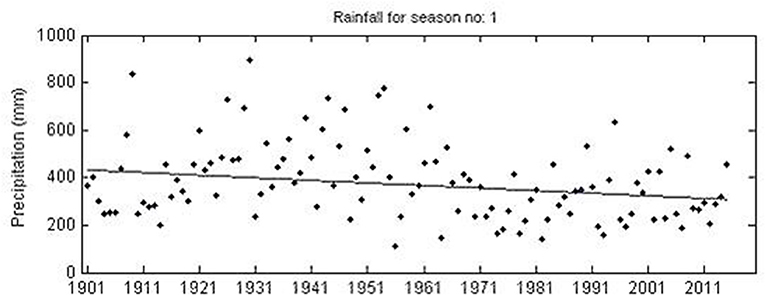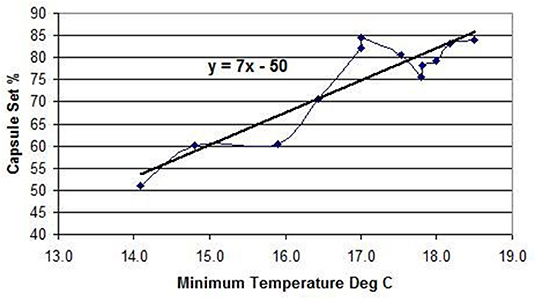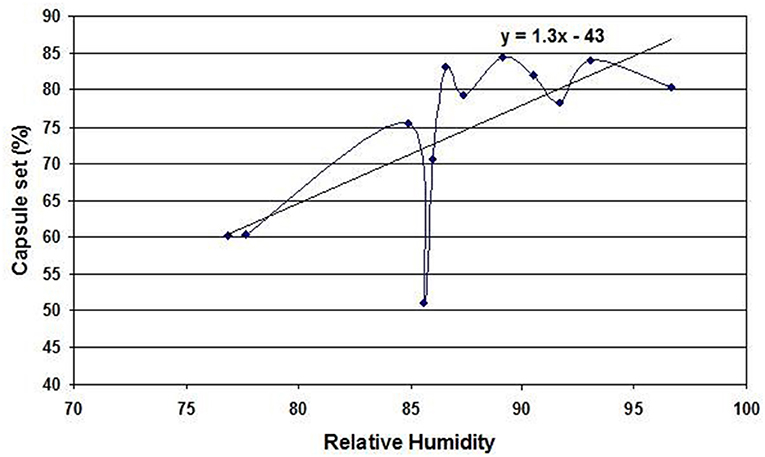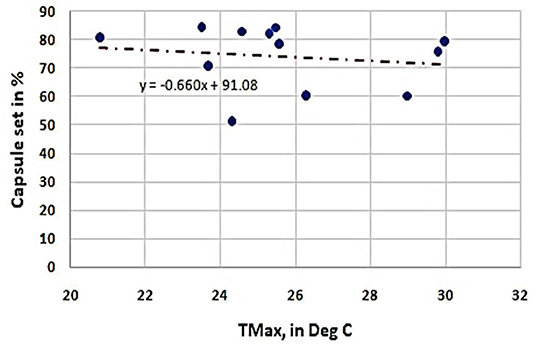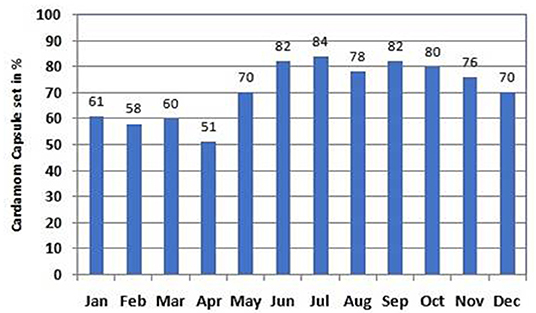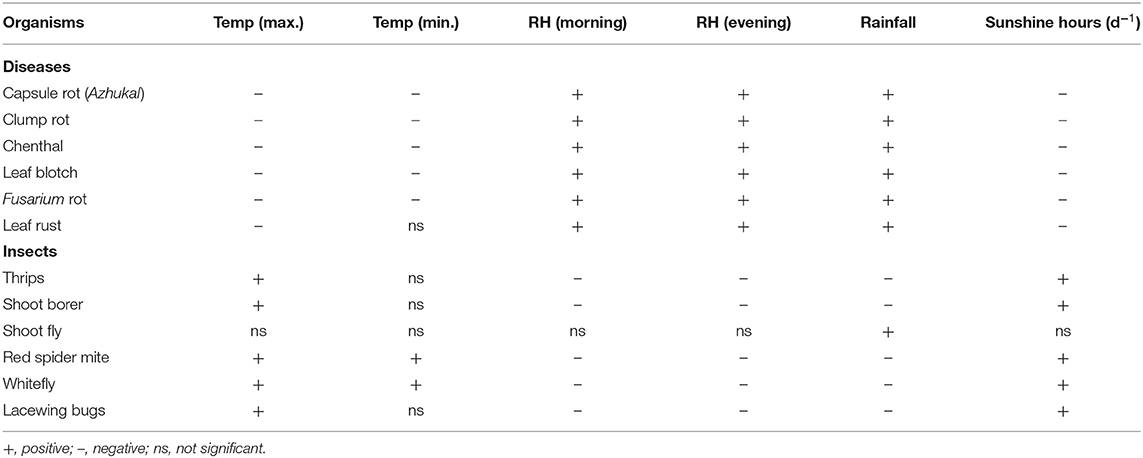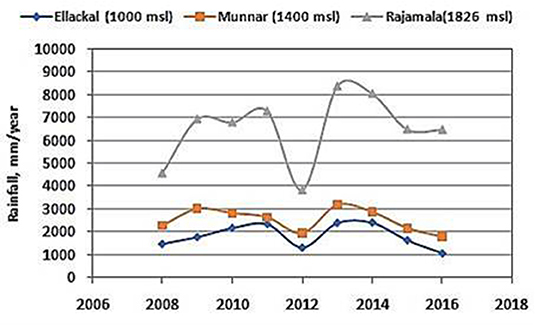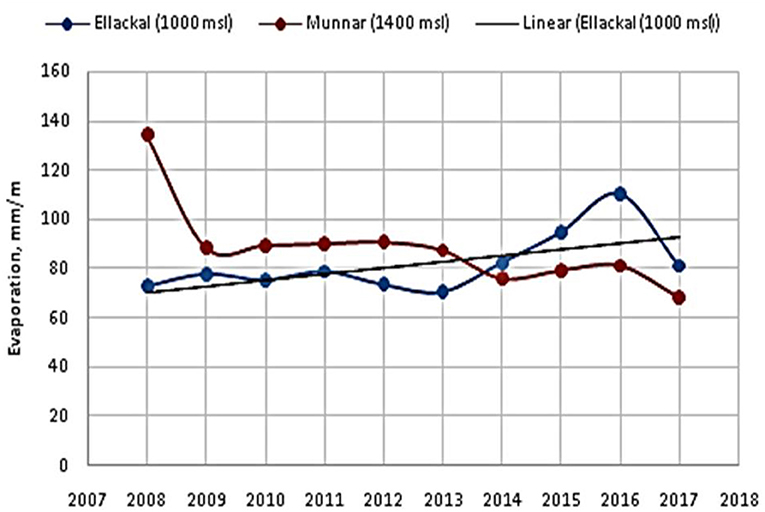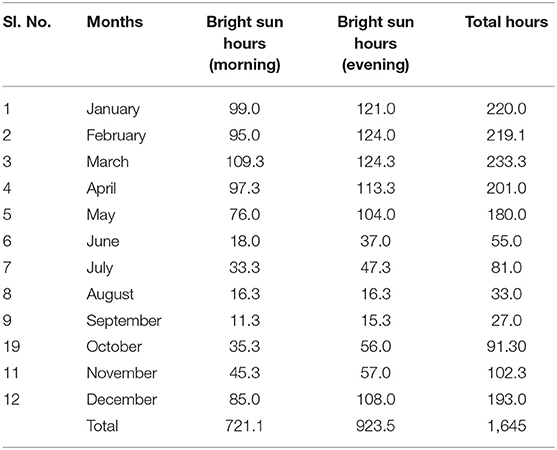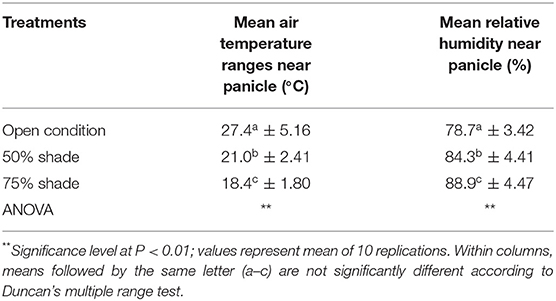- 1Cardamom Research Station, Kerala Agricultural University, Pampadumpara, India
- 2Indian Council of Agricultural Research (ICAR)-Indian Institute of Spices Research, Calicut, India
- 3Biological Systems Engineering, College of Agriculture and Food Sciences, Florida State A&M University, Tallahassee, FL, United States
- 4Department of Materials Engineering, Indian Institute of Science, Bangalore, India
Intensive cardamom cultivation in Indian Cardamom hills (ICH) has been related to severe ecological and environmental implications that can challenge the long-term sustainability of cardamom. This research study and analysis proposes a novel system approach for sustainable agroecological production of cardamom in southern India. The effects of intensive cardamom cultivation on its forest environment had been significant. A considerable increase in surface air temperature was observed in the ICH during the last three decades (1990–2020). The climate of the Cardamom hill reserves (CHR) has a very high variability of daily cycles (surface air temperature and relative humidity) compared to low variability of yearly cycles, which helped minor and major pests and diseases occur and spread throughout the season. The current hydrothermal condition of the soil fostered the occurrence of soil insect pests, resulting in higher pesticide use. Epiphytes peculiar to the CHR forest have been eliminated due to repeated, intense shade lopping of each tree. Variability occurred in cardamom growth and development and yield can be attributed to changes in the microclimatic environment prevailing in the micro habitats of the sloping hillsides. This study has revealed the possible link and various dimensions between the intensive growing practices that were positively reflected in its local climate and production system. The 75% shade level under the cardamom canopy influences the cardamom microclimatic conditions, the relative humidity close proximity with panicles was maximum (88.9%), and the mean air temperature was minimum (18.4°C). On the contrary, the relative humidity at canopy top was reduced (78.7%) but the mean air temperature was still high (27.4°C). This study also suggests that future energy transfers in the CHR production system must be understood for improving the long-term agricultural sustainability of cardamom cultivation in the ICH.
Introduction
Cardamom plantation activities in southern India are considered one of the most expensive farming practices globally, involving enormous inputs and external energy throughout the season (Murugan et al., 2017). Majority of the most successful cardamom plantations are available in Indian cardamom hills (ICH) in the elevation ranging from 700′ to 7,000′ above sea level. Nearly half a century ago, the ICH was a typical tropical evergreen forest with enormous biodiversity, including epiphytes. Ruthless regular shade lopping is the foremost essential operation that all planters would like to do in the ICH (Murugan et al., 2012a). This causes changes in micro and topoclimatic condition along with fast degradation of the forest structure and function. Published information, on the influence of altitudinal variability on evaporation and precipitation pattern and the hours of bright sun, is scarce for the cardamom hills agroforestry system (Pascal et al., 2004). Hence, the basic underlying concepts and possible factors discussed in this paper will be of great significance in understanding the linkages of the cardamom production system (Figures 1A–E). Thereby, both cardamom cultivation and forest management can be sustainably achieved.
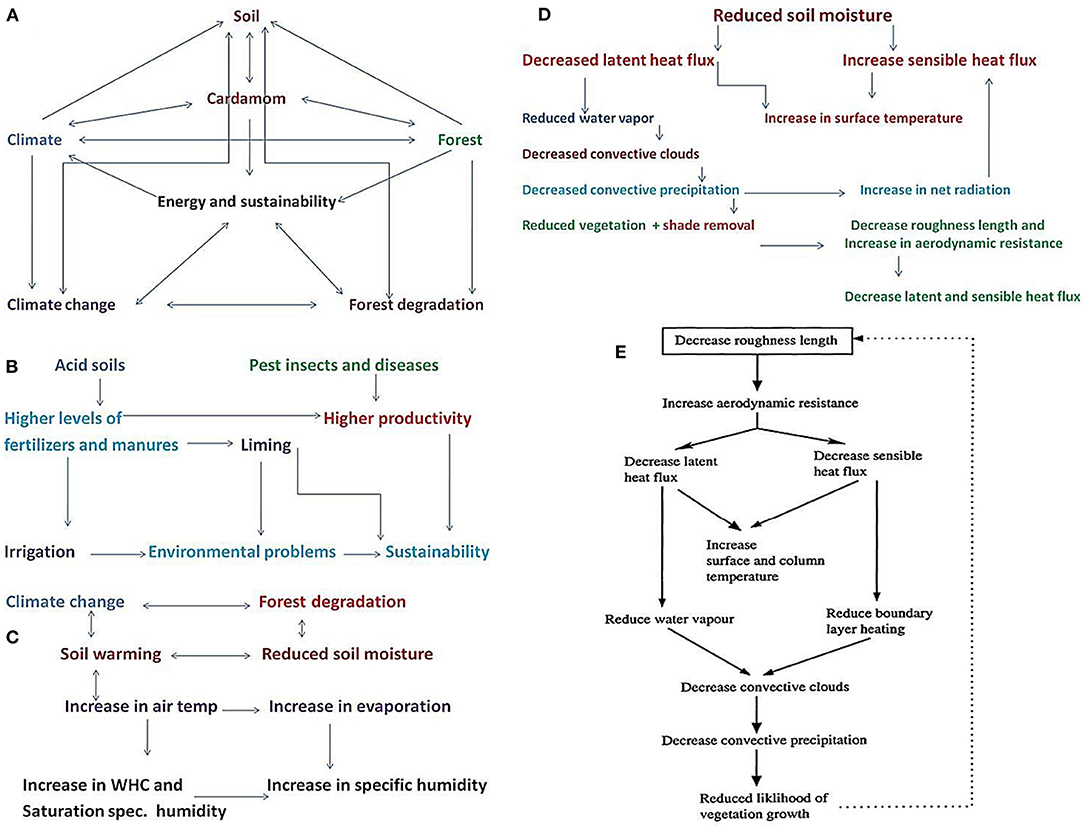
Figure 1. Schematic diagrams showing the linkages as well as cause and effects of the climatic variables due to forest degradation in cardamom cultivation. (A) The nexus of climate-cardamom-forest system. (B) Influencing factors and their relationships with cardamom production. (C) Impact of forest degradation on local weather elements. (D) Impact of shade removal on soil moisture and soil heat fluxes as well aerodynamic resistance. (E) Forest structure degradation and its impacts on convective precipitation (Courtesy: Climate Research Unit, UEA, Wales, Bangor).
It is factual that every tree with in the cardamom hill reserves (CHR), and its surrounding area, is subjected to severe lopping to the maximum extent possible to allow more sunlight throughout the rainy season. Planters have a conception that the removal of intensive regular shade will benefit the growth and yield of cardamom and believe the nexus of the climate-cardamom-forest system would be unaltered (Reyes et al., 2006; Dhakal et al., 2012). Practically, all cardamom plants are exposed to various unique topo and microclimatic environments, depending on the slope length, intensity, and surface properties like albedo and roughness (Stephenson et al., 1990; Flint et al., 2013). These parameters can change to a greater extent, mainly due to the excessive removal of tree canopies which is conducted by the planters when they desire. Variability in cardamom growth and development and yield can be susceptible to variation in the microclimatic environment prevailing in the microhabitats of the sloping hillsides (Moench, 1991).
In a forest-based tropical mountain agroecosystem, the micro-scale ecological processes, e.g., evaporation from the surface, light availability, and dewfall for crop plants, depend primarily on the radiative energy budget of a given relief unit. The light availability to crops under forests depends on the level of forest canopy/degradation and duration of cloudiness (Cournac et al., 2002). The surface albedo depends on the nature of surface cover (clean, cultivated, and weeded), exposure frequency (new planting), and crop rotation. Light availability and radiative energy input are the two critical parameters for shade-loving crops and plants (Piccotto and Tretiach, 2010). The radiative energy in the summer season is three times higher than in the winter season. But significant variability in the radiative budget in the north-south aspect is noticed for the winter period. North facing slopes receive about three times lower radiative energy than south-facing slopes. This implies that winter is the season with the largest micro-scale differences in the radiation budget (Littmann, 2008). Irrespective of direction, relatively slow cooling of soil and atmospheric air is observed for long, intense steep slopes than gentle and no sloping lands. Long easterly slopes with high gradient, cool down more slowly than their westerly counterparts. The implications and impacts of this on cardamom are evident from the less shaded cardamom agroforestry system (Murugan et al., 2009b). High altitude areas in the humid tropics are the only places where cold weather prevails and plays a significant role in plant, animal, and human life (Stephenson et al., 1990).
Cardamom is one of the high-value spice crops grown exclusively in the tropical mountain slopes and highlands. Except for Guatemala, the crop is cultivated as under growth of forest trees in India (southern Western Ghats) (Moench, 1991; Murugan et al., 2017), Sri Lanka (Knuckles Mountain) (Dhakal et al., 2012), and Tanzania (Usambara Hills) (Moench, 1991; Murugan et al., 2017). Cardamom is a rain-loving crop, that prefers a wet and chilly environment over a hotter or drier environment. Except for the easternmost slopes, where the mean annual maximum and minimum temperatures are 38 and 16°C, respectively, other ICH areas have a typical monsoon wet climate. Because of the position of the tropical belt as well as the general circulation of air masses at low latitudes, the climates of the tropical high uplands are particularly unique in their mix of characteristics (Reyes et al., 2006).
The air temperature declines with increasing altitude in tropical systems, without the confounding effects of seasonal variation. In contrast to temperate systems, where the growing period typically shortens with higher elevations, air temperature changes considerably in a day than seasonally (Murugan et al., 2009a). The growing period is no different from the low land to forest limit. Horizontal surfaces are reduced to small areas or are practically non-existent in tropical mountains with sharp and uneven relief. When this happens, the concept of regional climate loses a lot of its meaning. As a result, topo and microclimates have greater biological significance for cardamom than regional and macroclimates (Murugan et al., 2009b). The microclimatic condition in cardamom hills is determined by three factors: slope length, angle, and aspect, as well as roughness and relative topographic position. The daily weather pattern in many tropical highlands and mountains specifies that insolation on west-facing slopes is greatly reduced by cloudiness or fog during the afternoon, in contrast to east-facing slopes enjoying early morning sunshine (Korner, 2003). Easterly-facing sites receive more direct sunlight, resulting in drier conditions with higher maxima and lower minimum temperatures (Oldfather et al., 2016). Low temperature, low air pressure, low humidity, and an uneven distribution of light and high-speed winds have been observed at mountain heights. The easiest way to visualize cyclic climate changes in the tropics compares solar radiation along a latitudinal gradient from the equator to middle latitudes. As a result, tropical climates differ drastically from climates at mid- and high- latitudes in that they have less month-to-month variation in both mean temperatures and day length, a fact that allows us to regard tropical ecosystems to be surprisingly consistent (Daly et al., 2010).
The role of photosynthetic gas exchange in determining cardamom productivity under different canopy level remains poorly understood, particularly respect with canopy-dependent (i.e., sun leaves vs. shaded leaves) variation in the net photosynthesis, transpiration rate, and leaf temperature. Moreover, there is evidence of temperature dependent leaf photosynthetic gas exchange in tropical forest types (Slot et al., 2013), but to date, no study has adequately assessed the temperature dependence of net photosynthesis with canopy position in cardamom. Given these issues, canopy dependent variation in the photosynthesis gas exchange of cardamom needs to be more fully characterized.
Light is the most limiting factor for plant species in tropical rainforest biomes, declining markedly with increasing canopy depth when it penetrates the vertical dimension of the canopy (Yoshimura and Yamashita, 2012). As a result, the availability of light can be reduced by up to half fold from the upper canopy compared to leaves in the shaded lower canopy (Baldocchi et al., 2002). Such variations in irradiance lead to marked effects on leaf morphological, chemical and physiological traits (Niinemets et al., 2006; Kosugi et al., 2012).
Regardless of the causes of rainfall seasonality, many tropical areas have two or four distinct seasons, with rainless periods ranging from 1 to 6 months (January-June). The temperature regime may be significantly altered as a result of this annual pulse. The total solar radiation at ground level can drop due to high cloudiness during the wet seasons. However, the coldness due to outgoing longwave radiation from the ground and forest and crop vegetation can be considerably reduced due to high relative humidity at night (Buytaert et al., 2006). The amplitude of daily temperature variation can be reduced as a result of these combined impacts. Low cloudiness, clear skies, and a dry environment (low humidity) persist during the rainless period, resulting in greater day and lower night temperatures, which enhances the amplitude of daily temperature swings (Lundquist et al., 2008). Seasonality in rainfall results in thermoperiodism: an annual cycle characterized by dampened temperature oscillations and higher night minima during rainy seasons and stronger temperature swings and lower night minima during dry seasons. The seasons' variety in temperature oscillations, paired with humidity, has become a prominent mountain climate element in Cardamom hills. This paper determines the possible linkages involved in Indian cardamom production system.
Materials and Methods
Data Collection
Climate data was collected from various government organizations. The Cardamom Research Station (CRS) of Kerala Agricultural University (KAU), Pampadumpara, provided information on rainfall, air temperatures, relative humidity, and bright sun hours for the cardamom growing tract (1978–2018). The State (Kerala) Electricity Board (KSEB) supplied both evaporation and rainfall data (2000–2018) for three stations (Ellackal, Munnar, and Rajamala). Yield data on cardamom capsules for various time periods were collected from individual planters' registers (Table 1). Data on insect pests and disease incidence of cardamom were collected from the research station fields adjoining the observatory. The change in the tree species composition was calculated from (transect method) counting trees from five 1 ha plots selected randomly in cardamom growing areas including a research station farm. Daily rainfall amounts, as well as temperature and relative humidity values, were summed up to obtain monthly and annual values.
Environmental Condition and Gas Exchange Measurements
Observations on photosynthetic gas exchange parameters were measured using a portable photosynthetic system in yielding plants (4 years old) at three distinct canopy levels (4th leaf in the upper canopy; 8th leaf in the middle canopy; 12th leaf in the lower canopy) (LCpro-SD Advanced Photosynthesis Measurement System, England). Photosynthetic photon flux density (PPFD, mol m−2 s−1), net photosynthetic rate (A, mol m−2 s−1), stomatal conductance (gs, mol m−2 s−1), intercellular CO2 concentration (Ci, mol CO2 mol−1), transpiration rate (E, mmolH2O m−2 s−1), and leaf temperature (Tleaf) were quantified. Data were collected between 9:30 and 11:30 a.m. during sunny days (Alagupalamuthirsolai et al., 2019). Observations were taken during A and gs were stable. During the experiment, weather factors such as air relative humidity and surface air temperature near the panicles were also measured using a spinning psychrometer and an infrared thermometer.
Data Analysis
To discern means, data were subjected to the analysis of variance and Duncan's multiple range tests (DMRT), as stated by Duncan (1955). A significance level of p < 0.05 was used to discuss the data. WASP-Web Agri Stat Package 2.0 was used for other statistical analysis.
Results and Discussion
Observed Climatic Variability and Change in the ICH and Their Impact on Cardamom Cultivation
Intensive cardamom farming has had a significant influence on forest trees in the CHR. The CHR forest species composition has been diluted at great levels, as only three species (Vernonia arborea, Artocarpus heterophyllus, and Toona ciliata) account for more than half of the total number of populations. Except for a few rare and endangered species like Actinodaphne malabarica, Saraca asoca, and Kingiodendron pinnatum, the formerly ecologically stable and vital tree composition has vanished. In the Cardamom hills, Persea macrantha is the most common species. Cullenia exarillata and Palaquium ellipticum, the two native evergreen forest trees, have rapidly disappeared from the Cardamom hills (Murugan et al., 2009a; Jayaraj et al., 2011). Epiphytes that were distinctive to the CHR forest were completely eliminated due to frequent and heavy shade removal of trees. The CHR forest has been severely degraded during the past 25 years, reducing its roughness (structure) and species diversity (Figure 2). As a result, the once-healthy forest of the Cardamom hills have already degraded, and they are now unable to fulfill their ecological and environmental roles.
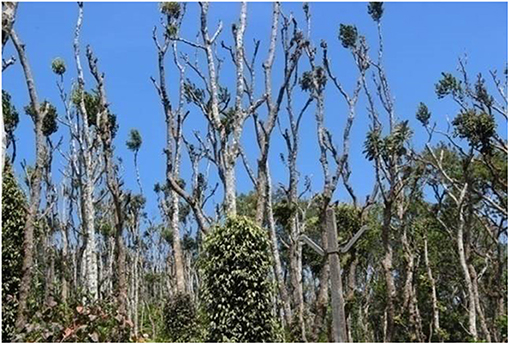
Figure 2. Roughness and shape of the pruned forest trees immediately after shade lopping in cardamom plantations.
Cardamom cultivars used to be seasonal, with flowering periods ranging from June to September, and only had four harvests per season (Murugan et al., 2011). Planters were eager for a steady increase in yield to maintain their economic superiority and this was accomplished by extensive research and planning by researchers and planters, who used the genetic diversity available at the time to identify high-yielding farmers' varieties such as green gold, Palakkad, etc. These varieties are succulent and highly responsive to chemical inputs as well as a less shaded environment. As a result, much of the forest canopy has been destroyed. Since 1978, the CHR has reported a decadal increase of 0.3°C in surface air temperature (SAT; Murugan et al., 2000). The increase in the mean annual temperature (T min) has been more significant at night, resulting in a decrease in the daily temperature range (DTR; Murugan et al., 2012a). Cardamom suckering and profuse tillering was driven throughout the season by temperature fluctuations, amplification at night and day, severe surface insolation, and increasingly bright daylight hours.
Farmers' most favorite cultivars now have 45% more tillering and 135% greater panicle (flower shoot) output, resulting in a multifold increase in fertilizer nutrient utilization. As a result, the pH of most of the planters' field soils ranges from severely acidic (3.5) to strongly acidic (5.5). Hence the CHR soils, upon long-term application of synthetic fertilizers and chemicals, resulted in a significant drop in soil pH (Murugan et al., 2017). Foliar and soil applications of nitrogenous fertilizers are becoming more common. Regular application of nitrogenous fertilizer sources (Ammonium-N) at a 250 kg/ha rate will rapidly boost hydrogen activity by six-fold, causing a pH drop of 1.0 unit. Finally, the soils will have to be heavily limed. Farmers' variety outperforms older clones (Kodukku Mysore) and when all inputs are given sufficiently, at least a four-fold improvement in production can be achieved in the hot spot cardamom growing areas (Table 1).
During the harvest season, cardamom curing is a sophisticated procedure that lasts 150–200 days a year. At least 1,500 units are actively involved in this job, which burns around 1.5 lakh tones of firewood every year. As a result, the amount of firewood consumed seasonally to cure fresh cardamom has increased three-fold in recent years. Other energy sources, such as electricity and diesel, are not recommended because they are unstable in supply and expensive. Depending on the type and quality (density) of the firewood used, massive amounts of CO2-containing smoke can be released into the atmosphere. Semi-soft wood materials have a carbon content of 450–500 g per kg of wood. In theory, burning 1 kg of firewood produces 1.65–1.80 kg of CO2. The CHR utilizes 1.5 lakh tons of firewood every year, releasing a significant amount of CO2 into the atmosphere. Other land uses in the CHR, such as pepper and coffee production systems, do not require fire energy for curing.
The relatively wide variety of daily cycles (surface air temperature and relative humidity) compared to the comparatively low variability of yearly cycles is one of the critical characteristics of the CHR climate, which aids the multiplication and spread of both minor and major pests and diseases throughout the season (Murugan et al., 2012b). The current popular high-yielding varieties like green gold have vigorous succulent tillers that are prone to insect pests and diseases. Planters use several rounds of chemical pesticides to control these pests (18 rounds yr−1). Most of the time, planters use a blend of pesticides. This raises severe concern about externalities and the CHR system's long-term viability (Shetty et al., 2011).
Even if an increase of 0.3°C in minimum temperature, over a decade, did not affect cardamom yields on decadal basis, increased nighttime respiration due to enhanced night time minima could reduce cardamom output depending on altitude and slope properties. Evaporation levels in cardamom hills have increased due to higher land/soil and surface air temperatures along with accelerated forest degradation. Depending on the elevation, increasing evaporation levels have been observed. Compared to the rainy season months, evaporation levels in the summer months were exceptionally high over the observed years. For the past 10 years, year-to-year changes have been particularly noticeable. Lower elevation sites had higher evaporation levels than higher elevation sites and the reason could be the altitude-induced lower temperature levels and the prevailing colder conditions at the mountain or higher elevation locations (Figure 3). Higher evaporation at lower elevations under a diminishing future rainfall scenario might accelerate soil drying necessitating early and frequent watering which would increase irrigation costs as well as ecosystem water demand. Lower elevation sites may also pump more moisture into the near-surface air, which could substantially impact the incidence of pests and diseases in valley points. The pumped moisture can change the saturation and absolute humidity levels and the air temperature over a short time. Because they are all interconnected (weather elements) in many ways, the combined effect of land/soil and surface air warming has an impact on the atmospheric air's water holding capacity (WHC) as well as specific humidity (actual moisture in the air). The combination of these weather parameters directly impacts cardamom capsule set (Figures 4–7) and pest infestation levels (root and foliar pests). Table 2 shows the relationship between meteorological elements, pests, and diseases of cardamom.
The volume and distribution of rainfall is the most influential climatic factors (in cardamom farming), followed by surface air moisture (humidity), and micro and topoclimate (mediated by slope length and aspect). The easternmost slopes of the CHR receives 1,500 mm of annual total rainfall, whereas the west-facing slopes near the Elappara range receive as high as 7,000 mm (Murugan et al., 2008). Rainfall has been shown to vary more spatially and temporally across the Cardamom hills. Although there have been significant variances and reductions in first monsoon rainfall, the amount of winter monsoon rainfall has been a growing concern in recent past years. Rainfall throughout the summer months (January to May) has a considerable positive link with yield. As a result, summer month rainfall and distribution are more significant than summer (June to September) and winter monsoon (October to December) rainfall for maintaining higher yields. The fact that more than century-scale precipitation is decreasing in the summer months is a striking feature (Figure 8). Our observations in the Cardamom hills revealed a comparable increase in rainfall as altitude increased (Henry, 1919; Sasaki and Kurihara, 2008; Figure 9). The variability of rainfall in smaller timescales have been high, as evidenced by observed long-term precipitation data as well as future climate (precipitation) change based on inter-comparison of 36 global climate models, implying that lower elevation plantations will be exposed to severe water scarcity much more; thereby increasing the cost of irrigation and cultivation. The planters at present provide a minimum of five irrigations in a 3-month dry period. Furthermore, the vital environmental resource (groundwater) will be put under more stress. As a result, cardamom farming may be pushed up to higher elevation sites in the future.
Over the last two decades, Pampadumpara has seen an average increase of more than 1 h in bright sun hours. Higher maxima and a longer period of insolation have been reported on east-facing slopes due to a lower frequency of clouds in the morning than in the afternoon. Higher minimum temperatures were observed due to drier soils, perhaps due to increased evaporation under conditions of increased insolation. Before the overcast had built up in the morning, the soil temperatures on the easterly slopes were up to 10°C warmer at 5 cm. However, the cloud cover limited the warming effect of direct sunlight in the afternoon, and the west-facing slope was just a few degrees warmer. As a result, changes in the east-west aspect in tropical highlands, including the Cardamom hills, could be a key ecological factor for cardamom growth. The Cardamom hills annually receive less sunshine (bright) than the Upper Pulnis (Kodai hills), which is in the order of 1,630 and 2,560 h, respectively (Fyson, 1915). Nearly 65% of bright sun hours come from the first 5 months (January to May), which coincides with the tillering and flowering phase of cardamom, and the remaining 35% of bright sun hours are received through June to December, synchronizing the development, maturity, and harvesting of capsules. March is the brightest month with 233 h, but the cloudiest month is September, receiving only 33 h (Table 3). The bright sun hours vary considerably among months and seasons in these tropical mountains. The period from January to May has recorded higher levels of sunshine, meaning this period has the minimum cloudiness coupling with elevated air temperature causing more evapotranspiration from irrigated cardamom fields. Not much variation occurs concerning the north and south's slope and aspect during the summer season. In most of the months, bright hours far exceed the morning time sunny hours except during July, August, and September. Therefore, the west and south-west facing slope will receive more sunlight than the other counterparts resulting in a huge difference in soil hydrothermal conditions. This is why the scorching effect on cardamom plants can be pronounced under such non-irrigated, sparsely shaded fields during March through May. More trees and higher shade levels must be maintained in the south and west-facing slopes to avoid or reduce the scorching effects of long bright sun hours. Irrespective of the pole direction and aspect, most planters go for severe shade lopping, which will negatively impact the long-term sustainability of the production system and the ecosystem as a whole.
Soil temperature data are significantly more essential for better knowledge of ecosystem services and processes such as soil nutrient dynamics and soil microbial communities and their activities, which improve overall environmental quality. Surprisingly, data and information on soil temperature are extremely sparse world-wide for key agroecosystems. Long-term soil temperature research is scarce in India and hence, published material is sparse. Since 1990, a steady increase in soil temperatures in the top 15–20 cm soil layer has been observed at Pampadumpara. For the hottest years, such as 2002 and 2012, the data showed a sudden increase in cumulative mean soil temperatures across seasons. Over the years, maximum soil temperature was recorded in March (37.1°C), while the lowest was recorded in November (22.2°C). Regardless of time or soil depth, increased soil temperatures have been documented in March and April. In the past 25 years, a significant rising trend in soil temperature at depths of 5 and 10 cm (both with p < 0.05) has been observed, which positively correlates with the age of extensive soil insect infestation (Murugan et al., 2017).
The topography, vegetation, and land-use change in tropical mountain areas cause significant variations in relative humidity through a season. With increasing air temperature, the equilibrium relative humidity will rise over time. A strong link between air temperature and relative humidity is important for phenology and pathogenic infection in many crops. In cardamom, capsule set is strongly correlated with air humidity and temperatures. The lowest capsule set percentage was recorded for April (51%), followed by February (58%) and March (60%). July (84%) registered a maximum capsule set closely followed by September (82%) and June (82%). Generally, monsoon months have higher relative humidity levels; therefore, the capsule set is also high compared to the non-monsoon and summer months. For all three seasons, relative humidity at Pampadumpara station has risen over the last two decades. The month of April had the highest monthly relative humidity increase, followed by March and October. August and June had seen the least amount of growth. From 1980 to 1990 and 2000 to 2007, there was a more significant variation in the winter monsoon (October, November, and December). During the study period, an increased relative humidity was seen at the neighboring Myladumpara station in all three seasons. April had the highest monthly relative humidity increase, followed by March, May, and December. From 1991 to 1995 and 2000 to 2006, the relative humidity fluctuated more throughout the winter monsoon months. Another location (Vandiperiyar station) has shown both growing (seasons 2 and 3) and declining (season 2) tendencies. Summer months (January to April) had higher relative humidity levels, while months from June to December had lower relative humidity levels. For the early monsoon months (1997–2002) varying degrees of relative humidity were noticed (June-September). During the winter monsoon months (October to December) more significant oscillations were seen in Vandiperiyar, primarily between 1990 and 1995. Variations in roughness, bright sun hours, rainfall volume, and distribution, as well as irrigation levels may have contributed to these differences.
Influence of Shade Levels on Cardamom Physiology and Microclimatic Condition
Limitations to leaf photosynthesis were explored from three canopy positions (upper leaves, middle leaves, and lower leaves) of field-grown cardamom under different irradiance level (open condition, 50 and 75% shade). Overall, compared to shaded leaves (irrespective of leaf position), sun leaves (upper) under open condition had a higher net photosynthetic rate (A, 3.79 against 2.0 μmol m−2 s−1) as well as high stomatal conductance (gs) and transpiration rate (E) (due to optimum irradiance availability PPFD 300–900 mmol m−2 s−1) but unrelated to internal CO2 concentration (Ci). In the present study, under open condition cardamom canopy (upper leaves) received PPFD not more than 830 mmol m−2 s−1 during July. The higher A under the optimum PPFD value (300–900 mmol m−2 s−1) is in agreement with earlier observation for small cardamom (Alagupalamuthirsolai et al., 2018). The intrinsic low A in cardamom is associated with low diffusive limitations (Table 4), the efficiency of photosystem II, as well as other biochemical constraints (data not shown) under various irradiance levels. Morphological plasticity should be the greater acclimative value (plant height, active physiological tillers, capsule setting percentage, and leaf rolling mechanism during hot bright mid-day) than physiological plasticity as a mean of cardamom leaves to respond to changing irradiance (Alagupalamuthirsolai et al., 2018, 2019). Also, the leaves of cardamom plants are exposed to PPFD 300–900 mmol m−2 s−1 to improve the growth and capsule yield. Further, the PPFD >900 mmol m−2 s−1 increased the α-terpinyl acetate (responsible for sweet aroma) whereas PPFD <500 mmol m−2 s−1 increased the percentage of 1,8-cineole (gives a camphorous aroma) in cardamom seeds. The incidence of insect pests like thrips and bores on capsules was not affected by different irradiance level, but the damage on shoots by Conogethes punctiferalis Guen was more under PPFD <500 mmol m−2 s−1 (Alagupalamuthirsolai et al., 2019). A significant difference in internal leaf temperature (Tleaf) was observed between upper and lower leaves in all irradiance levels except in the upper leaf of open irradiance plants (governed by circadian components like partial leaf folding mechanism) to reduce irradiance exposure.
Surface air temperature and air relative humidity were the most critical for flowering, fruiting, and chemical quality of cardamom (Oommen et al., 2018). The mean air RH (daily mean) near the panicle has differed significantly between shade level, and the levels of RH were 78.7, 84.3, and 88.9% under open condition, 50 and 75% shade, respectively (Table 5). The climate is slightly warmer near panicles and it has significantly varied between shade levels. The air temperature near the panicle (daily mean) was 27.4, 21.0, and 18.4°C under open condition, 50 and 75% shade, respectively (Alagupalamuthirsolai et al., 2019).
Conclusion
The ICH hills are undergoing a rapid environmental change because of the continuous high consumption of agrochemicals under intensive cardamom cultivation. The cardamom ecosystem is also experiencing heavy loss of forest vegetation that is wiping out the biodiversity of the Indian Cardamom hills. At least 55–60% of forest tree stand has been modified and contributed by only three introduced species (Vernonia arborea, Toona ciliata, and Artocarpus heterophyllus). Climate change has had a favorable impact on cardamom agriculture in that it has helped enhance yield and productivity by several times. The phenomenal increase in productivity of the current popular varieties has been primarily attributed to significant changes and variations in the atmospheric and soil-climatic elements. Meanwhile, previously high yielding types of cardamom had never been exposed to such variability and changes and input levels (chemicals, energy, and shade removal). As a result, the CHR forest's biodiversity, structure, and function have all significantly declined. In the CHR forest, only three species account for more than 60% of all individuals. The CHR forest is missing at least 95% of epiphytic diversity. Cardamom genetic diversity has disappeared totally from planters' fields, resulting in a lack of genetic diversity in the global cardamom hot spot (GCHS). Chemicalized cardamom farming has damaged the health and quality of the soil. Cardamom cultivation in CHR has increased pests and disease concerns, posing a serious threat. Planters believe that immersing the cardamom plantation is necessary for pest and disease management. If this is the case, the queen of spices (cardamom) will rise to the king of pesticide usage, turning the kingdom of spices into a land of poisons. Cardamom cultivation has increased its cost of production by a factor of ten, resulting in a steadily diminishing net profit, making economic viability improbable. The prevailing perilous situation of biodiversity loss and soil-water environmental degradation must be changed appropriately so that ecosystem health and sustainability can be restored. Energy transfers in the CHR ecosystem explored in the future will help to improve cardamom cultivation's ICH long-term agricultural sustainability.
The cardamom microclimatic conditions inside the cardamom canopy are influenced by shade level. At 75% shade level, air relative humidity close to surfaces was highest, while the mean air temperature was lowest. The relative humidity near the surface was lowered in open conditions, while the mean air temperature remained high. Maintaining a higher shade level has improved the cardamom canopy at the microclimatic level.
Data Availability Statement
The original contributions presented in the study are included in the article/supplementary material, further inquiries can be directed to the corresponding author/s.
Author Contributions
MM and AA conceived the idea, initiated the whole work besides RCP analysis, and prepared the manuscript. RR performed statistical analysis. KA, MA, and MD collected and compiled the data on climatic variables. TS prepared the schema. All authors read and approved the final manuscript.
Funding
This article is based upon work partially supported by National Science Foundation Grant no. 1735235 awarded as part of the National Science Foundation Research Traineeship and USDA-NIFA capacity building grant 2017-38821-26405.
Conflict of Interest
The authors declare that the research was conducted in the absence of any commercial or financial relationships that could be construed as a potential conflict of interest.
Publisher's Note
All claims expressed in this article are solely those of the authors and do not necessarily represent those of their affiliated organizations, or those of the publisher, the editors and the reviewers. Any product that may be evaluated in this article, or claim that may be made by its manufacturer, is not guaranteed or endorsed by the publisher.
Acknowledgments
This paper was dedicated to the loving memory of Prof. Rangaswamy Ramesh, Climatologist, NISER, Odisha whose inspiration made the senior author publish this paper. Limited parts of the content of this manuscript have been presented (impact of climate change in cardamom cultivation) at the [National Symposium on Spices and Aromatic Crops (SYMSAC IX), Spices for Doubling Farmer's Income, Murugan, 2018]. The authors wish to thank the Kerala state electricity board for the climate data.
References
Alagupalamuthirsolai, M., Ankegowda, S. J., and Krishnamurthy, K. S. (2018). Effect of different shade levels on growth, physiology and biochemical characteristics of small cardamom (Elettaria cardamomum Maton). Curr. J. Appl. Sci. Technol. 28, 1–9. doi: 10.9734/CJAST/2018/42040
Alagupalamuthirsolai, M., Ankegowda, S. J., Murugan, M., Sivaranjani, R., Balaji, R., and Akshitha, H. J. (2019). Influence of light intensity on photosynthesis, capsule yield, essential oil and insect pest incidence of small cardamom [Elettaria cardamomum (L.) Maton]. J. Essent. Oil Bear. Plants 22, 1172–1181. doi: 10.1080/0972060X.2019.1690587
Baldocchi, D. D., Wilson, K. B., and Gu, L. (2002). How the environment, canopy structure and canopy physiological functioning influence carbon, water and energy fluxes of a temperate broad-leaved deciduous forest—an assessment with the biophysical model CANOAK. Tree Physiol. 22, 1065–1077. doi: 10.1093/treephys/22.15-16.1065
Buytaert, W., Célleri, R., Bièvre, B. D., Cisneros, F., Wyseure, G., Deckers, J., et al. (2006). Human impact on the hydrology of the Andean páramos, Earth Sci. Rev. 79, 53–72. doi: 10.1016/j.earscirev.2006.06.002
Cournac, L., Doubis, M. A., Chave, J., and Riera, B. (2002). Fast determination of light availability and leaf area index in tropical forests. J. Trop. Ecol. 18, 295–302. doi: 10.1017/S0266467402002201
Daly, C., Conklin, D. R., and Unsworth, M. H. (2010). Local atmospheric decoupling in complex topography alters climate change impacts. Int. J. Climatol. 30, 1857–1864. doi: 10.1002/joc.2007
Dhakal, B., Pinard, M. A., Nimalgunatilleke, I. A. U., Savitrigunatillek, C. V., Madawalaweerasinghe, H. M. S. P., Dharmaparakrama, A. L. S., et al. (2012). Impacts of cardamom cultivation on montane forest ecosystems in Sri Lanka. For. Ecol. Manage. 274, 151–160. doi: 10.1016/j.foreco.2012.02.021
Duncan, D. B. (1955). Multiple range and multiple F tests. Biometrics 11, 1–42. doi: 10.2307/3001478
Flint, L. E., Flint, A. L., Thorne, J. H., and Boynton, R. (2013). Fine-scale hydrologic modeling for regional landscape applications: the California Basin Characterization Model development and performance. Ecol. Proc. 2, 1–21. doi: 10.1186/2192-1709-2-25
Henry, A. J. (1919). Increase of precipitation with altitude. Monthly Weather Rev. 47, 33–41. doi: 10.1175/1520-0493(1919)47<33:IOPWA>2.0.CO;2
Jayaraj, R., Sandeep, S., Hrideek, T. K., Mallikarjunaswamy, G. E., Amruth, M., Sajeev, T. V., et al. (2011). Environmental Impact of Pesticide Application in Cardamom Hill Reserves (CHR) of Southern Western Ghats. KFRI Research Report, 525.
Korner, C. (2003). Alpine Plant Life: Functional Plant Ecology of High Mountain Ecosystems. Heidelberg: Springer. doi: 10.1007/978-3-642-18970-8
Kosugi, Y., Takanashi, S., Yokoyama, N., Philip, E., and Kamakura, M. (2012). Vertical variation in leaf gas exchange parameters for a Southeast Asian tropical rainforest in Peninsular Malaysia. J. Plant Res. 125, 735–748. doi: 10.1007/s10265-012-0495-5
Littmann, T. (2008). “Topoclimate and microclimate,” in Arid Dune Ecosystems. Ecological Studies (Analysis and Synthesis), Vol. 200, eds S. W. Breckle, A. Yair, and M. Veste (Berlin; Heidelberg: Springer), 175–182. doi: 10.1007/978-3-540-75498-5_12
Lundquist, J. D., Pepin, N., and Rochford, C. (2008). Automated algorithm for mapping regions of cold-air pooling in complex terrain. J. Geophys. Res. 113:D22107. doi: 10.1029/2008JD009879
Moench, M. (1991). Soil erosion under a successional agroforestry sequence: a case study from Idukki District, Kerala, India. Agrofor. Syst. 15, 31–50. doi: 10.1007/BF00046277
Murugan, M. (2018). “Impact of climate change in cardamom cultivation,” in National Symposium on Spices and Aromatic Crops (SYMSAC IX) Spices for Doubling Farmer's Income 15–17 March 2018 (Kozhikode: Indian Society for Spices; Rural Development, Nagaland University, Medziphema Campus), 130–136.
Murugan, M., Mukund, V., Ramesh, R., Hiremath, M. B., Josephrajkumar, A., and Shetty, P. K. (2008). Centennial rainfall variation in semi-arid and tropical humid environments in the cardamom hill slopes, southern Western Ghats, India. Caspian J. Environ. Sci. 6, 31–39.
Murugan, M., Panigrahy, B. K., Shetty, P. K., Subbiah, A., and Ravi, R. (2012a). Effect of heavy metal and nutrient uptake by soils in Indian Cardamom Hills. J. Soil Sci. Environ. Manag. 3, 196–206. doi: 10.5897/JSSEM11.091
Murugan, M., Raj, N. M., and Joseph, C. R. (2000). Changes in climatic elements and their impact on production of cardamom (Elettaria cardamomum M.) in the cardamom hills of Kerala; India. J. Spices Aromatic Crops 9, 157–160.
Murugan, M., Ravi, R., Anandhi, A., Sajan, K., and Dhanya, M. K. (2017). Pesticide use in Indian cardamom needs change in cultivation practices. Curr. Sci. 113, 1058–1063. doi: 10.18520/cs/v113/i06/1058-1063
Murugan, M., Shetty, P. K., Mukund, V., Panigrahy, B., and Josephrajkumar, A. (2009a). Soil and surface air warming in cardamom ecosystem in Southern Western Ghats, Kerala, India. Int. J. Agric. Rural Dev. 3, 35–44.
Murugan, M., Shetty, P. K., Ravi, R., Anandhi, A., and Josephrajkumar, A. (2012b). Climate change and crop yields in the Indian Cardamom Hills, 1978-2007 CE. Clim. Change 110, 737–753. doi: 10.1007/s10584-011-0115-8
Murugan, M., Shetty, P. K., Ravi, R., and Subbiah, A. (2009b). The physiological ecology of cardamom (Elettaria cardamomum M) in cardamom agroforestry system. Int. J. Environ. Res. 3, 35–44.
Murugan, M., Shetty, P. K., Ravi, R., Subbiah, A., and Hiremath, M. B. (2011). Environmental impacts of intensive cardamom (small) cultivation in Indian cardamom hills: the need for sustainable and efficient practices. Recent Res. Sci. Technol. 3, 9–15.
Niinemets, Ü., Cescatti, A., Rodeghiero, M., and Tosens, T. (2006). Complex adjustments of photosynthetic potentials and internal diffusion conductance to current and previous light availabilities and leaf age in Mediterranean evergreen species Quercus ilex. Plant Cell Environ. 29, 1159–1178. doi: 10.1111/j.1365-3040.2006.01499.x
Oldfather, M. F., Britton, M. N., Papper, P. D., Koontz, M. J., Halbur, M. M., Dodge, C., et al. (2016). Effects of topoclimatic complexity on the composition of woody plant communities. AoB Plants 8:plw049. doi: 10.1093/aobpla/plw049
Oommen, M., Xavier Reivax, B. A., Vadiraj, P. M., Suresh, K., and Remashree, A. B. (2018). Quality appraisal of small cardamom (Elettaria cardamomum Maton) sourced from A, B and C zones of CHR in Idukki district of Kerala, India. J. Essent. Oil Bear. Plants 21, 1315–1326. doi: 10.1080/0972060X.2018.1538821
Pascal, J. P., Ramesh, B. R., and Franceschi, D. D. (2004). Wet evergreen forest types of the southern western ghats, India. Trop. Ecol. 45, 281–292.
Piccotto, M., and Tretiach, M. (2010). Photosynthesis in chlorolichens: the influence of the habitat light regime. J. Plant Res. 123, 763–775. doi: 10.1007/s10265-010-0329-2
Reyes, T., Luukkanen, O., and Quiroz, R. (2006). Small cardamom-precious for people, harmful for mountain forests. Mountain Res. Dev. 26, 131–137. doi: 10.1659/0276-4741(2006)26131:SCFPHF2.0.CO;2
Sasaki, H., and Kurihara, K. (2008). Relationship between precipitation and elevation in the present climate reproduced by the non-hydrostatic regional climate mode. SOLA 4, 109–112. doi: 10.2151/sola.2008-028
Shetty, P. K., Hiremath, M. B., Murugan, M., and Nerli, R. B. (2011). Farmers health externalities in pesticide use predominant regions in India. World J. Sci. Technol. 1, 1–11.
Slot, M., Wright, S. J., and Kitajima, K. (2013). Foliar respiration and its temperature sensitivity in trees and lianas: in situ measurements in the upper canopy of a tropical forest. Tree Physiol. 33, 505–515. doi: 10.1093/treephys/tpt026
Stephenson, N. L., Naturalist, A., and May, N. (1990). Climatic control of vegetation distribution: the role of the water balance. Am. Nat. 135, 649–670. doi: 10.1086/285067
Keywords: cardamom, novel system approach, relative humidity, light intensity, temperature
Citation: Murugan M, Ashokkumar K, Alagupalamuthirsolai M, Anandhi A, Ravi R, Dhanya MK and Sathyan T (2022) Understanding the Effects of Cardamom Cultivation on Its Local Environment Using Novel Systems Thinking Approach-the Case of Indian Cardamom Hills. Front. Sustain. Food Syst. 6:728651. doi: 10.3389/fsufs.2022.728651
Received: 21 June 2021; Accepted: 16 February 2022;
Published: 07 April 2022.
Edited by:
Abid Hussain, International Centre for Integrated Mountain Development, NepalReviewed by:
Nasir Mahmood, Pir Mehr Ali Shah Arid Agriculture University, PakistanSabarnee Tuladhar, International Centre for Integrated Mountain Development, Nepal
Copyright © 2022 Murugan, Ashokkumar, Alagupalamuthirsolai, Anandhi, Ravi, Dhanya and Sathyan. This is an open-access article distributed under the terms of the Creative Commons Attribution License (CC BY). The use, distribution or reproduction in other forums is permitted, provided the original author(s) and the copyright owner(s) are credited and that the original publication in this journal is cited, in accordance with accepted academic practice. No use, distribution or reproduction is permitted which does not comply with these terms.
*Correspondence: Muthusamy Murugan, bXV0aHVwZXlhbkBnbWFpbC5jb20=; Kaliyaperumal Ashokkumar, YmlvdGVjaC5hc2hva0BnbWFpbC5jb20=
 Muthusamy Murugan1*
Muthusamy Murugan1* Kaliyaperumal Ashokkumar
Kaliyaperumal Ashokkumar M. Alagupalamuthirsolai
M. Alagupalamuthirsolai Thiravidamani Sathyan
Thiravidamani Sathyan
